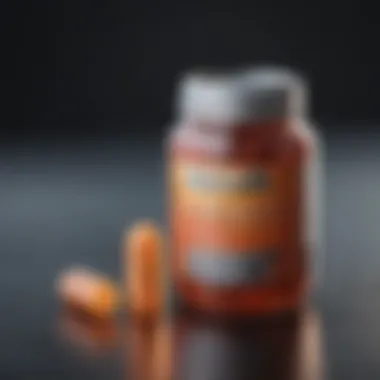Guidelines for Safe and Effective Tadalafil Usage


Intro
Tadalafil is a medication primarily known for its effectiveness in treating erectile dysfunction. It is also used to manage conditions like pulmonary arterial hypertension. Nevertheless, understanding how often one should use tadalafil is of utmost importance. The correct frequency can optimize its benefits while reducing side effects.
This article discusses guidelines for the appropriate frequency of tadalafil usage. Key considerations include recommended dosages, factors that influence how often it should be taken, and misunderstandings surrounding its use. This information will help both healthcare professionals and patients make informed choices.
Summary of Objectives
The main objective of this article is to provide a clear overview of the frequency guidelines for tadalafil usage. It aims to explore various facets involved in determining the correct usage frequency while addressing common queries.
Importance of the Research
Ensuring optimal tadalafil usage is essential for maximizing therapeutic outcomes. Misunderstandings regarding dosage can lead to inadequate treatment or unwanted side effects. The insights offered here are beneficial not only for individuals who take tadalafil but also for healthcare providers prescribing this medication.
Results and Discussion
Presentation of Findings
Research indicates that tadalafil can be taken as needed or on a daily basis, depending on the condition being treated. For erectile dysfunction, a common dose is 10 mg taken before sexual activity. However, some may benefit from a lower dosage of 5 mg or a higher one of 20 mg.
For long-term management, taking tadalafil daily in a lower dose (2.5 mg or 5 mg) has shown to be effective.
Key factors affecting how often tadalafil is used include:
- Age
- Overall health
- Severity of erectile dysfunction
- Presence of other medical conditions
Implications of Results
The findings presented suggest significant flexibility in how tadalafil can be utilized. However, users must adhere to recommended dosages to avoid adverse effects, such as headaches or digestive issues.
Understanding the dosage and frequency of tadalafil administration is crucial to avoid both ineffectiveness and health risks.
Additionally, it is important to acknowledge common misconceptions. Many believe that taking more tadalafil will lead to better results. This is false and can be harmful. Proper education is vital in preventing misuse.
Preface to Tadalafil
Tadalafil is a phosphodiesterase type 5 (PDE5) inhibitor primarily used for treating erectile dysfunction (ED) and the symptoms of benign prostatic hyperplasia (BPH). This section serves as an introduction to the medication, highlighting its importance and various elements surrounding its use. Understanding tadalafil is critical for both healthcare providers and patients. A better grasp of the drug’s function, its benefits, and its considerations fosters more informed decisions regarding erectile health.
Overview of Tadalafil
Tadalafil was approved by the U.S. Food and Drug Administration in 2003. It works by relaxing blood vessels and enhancing blood flow to specific areas of the body. This mechanism is particularly significant for men experiencing ED, as it leads to improved penile erection in response to sexual stimulation. Moreover, tadalafil's prolonged duration of action—up to 36 hours—distinguishes it from other similar medications, allowing for more spontaneity in intimate moments.
The pharmacokinetic profile of tadalafil exhibits a unique property where it can be taken daily in lower doses. This offers an alternative approach for those who prefer not to time their medication closely with sexual activity. Understanding these properties is essential when discussing the appropriate frequency of use and potential well-being benefits it may present.
Common Uses of Tadalafil
Apart from its primary indication for erectile dysfunction, tadalafil is also prescribed for other conditions, including:
- Benign Prostatic Hyperplasia (BPH): It alleviates urinary symptoms associated with an enlarged prostate.
- Pulmonary Arterial Hypertension (PAH): Tadalafil reduces blood pressure in the pulmonary arteries, improving exercise capacity in affected patients.
- Sexual Dysfunction: It is also used off-label to manage sexual dysfunction in women, although this use is less common.
The widespread use of tadalafil across different conditions underscores its versatility and the importance of understanding both its benefits and how to use it effectively. For optimal results, patients must be aware of the guidelines governing its frequency of use, ensuring safety and effectiveness.
Pharmacokinetics of Tadalafil
Understanding the pharmacokinetics of tadalafil is crucial for comprehending how this medication operates in the body. This section will detail the processes of absorption, metabolism, and elimination, which directly influence the recommended dosage and frequency of use.
Absorption and Metabolism
When ingested, tadalafil is rapidly absorbed, reaching peak plasma concentrations within 30 to 120 minutes. Food intake does not significantly impact its absorption, which is beneficial for patients who may take the drug with or without meals. Once in the bloodstream, tadalafil undergoes metabolism primarily in the liver by the enzymes cytochrome P450 3A4 and 2C19. This metabolic pathway is particularly relevant, as the presence of other medications that affect these enzymes can lead to altered tadalafil levels in the body.
The primary metabolite, which is less active than the parent compound, contributes minimally to the drug's overall efficacy. Recognizing this metabolic interaction is vital to preventing potential complications that might arise from polypharmacy.


Elimination Half-Life
Tadalafil has a notably long elimination half-life, averaging about 17.5 hours. This means that the drug remains active in the system for an extended period, allowing for flexible usage patterns. The length of the half-life serves to differentiate tadalafil from other erectile dysfunction treatments, which often require more frequent dosing.
The long half-life facilitates spontaneous sexual activity, as opposed to planning around a shorter dosing interval. Importantly, both renal and hepatic functions can influence the clearance of tadalafil from the body. Individuals with compromised kidney or liver function may experience delayed elimination, necessitating medical guidance regarding appropriate dosing schedules.
"The pharmacokinetics of tadalafil is essential for understanding its efficacy and safety in various patient populations."
Summary
In summary, the pharmacokinetics of tadalafil demonstrates significant implications for its use. By understanding how tadalafil is absorbed, metabolized, and eliminated, healthcare providers can tailor treatment protocols to suit individual patient needs, improve outcomes, and reduce adverse effects. Recognizing these pharmacokinetic principles is essential for effective medication management in erectile dysfunction therapy.
Recommended Dosage Guidelines
Understanding the recommended dosage guidelines for Tadalafil is critical for achieving its intended effects, especially in the treatment of erectile dysfunction. Proper dosage impacts both efficacy and safety, where incorrect dosing can lead to ineffective treatment or increase the risk of adverse effects. Establishing a clear framework for dosage can help patients and healthcare providers make informed decisions, ensuring that medication is used safely and effectively.
Initial Dosage Recommendations
Tadalafil can be prescribed for as-needed use or daily use, which directly impacts the initial dosage given to a patient. For on-demand use, the typical starting dosage is 10 mg, taken prior to anticipated sexual activity. This can be adjusted based on individual response and tolerability. Importantly, Tadalafil should not be taken more than once in a 24-hour period. For daily use, typically a lower dosage of 2.5 mg or 5 mg is recommended. This allows the medication to be effective at all times, eliminating the need for timing related to sexual activity.
"The initial dosage lays the groundwork for treatment efficacy. Patients should always consult their physician to establish the most suitable starting point."
Physicians might decide to lower the initial dosage in cases of specific health conditions or if a patient is taking medications that could interact negatively with Tadalafil. Patient assessments should take into account factors like weight, age, and overall health status, ensuring a tailored approach.
Frequency of Use
The frequency of Tadalafil usage hinges upon the prescribed dosage type. For those on-demand dosages, intake occurs before sexual activity, limited to once per day. Daily users effectively integrate the medication into their routine. This can lead to varied sexual experiences, as the drug remains active and effective in the system.
When considering the frequency of use, it is crucial to acknowledge the pharmacokinetics of Tadalafil, including its half-life. Tadalafil has a notably longer half-life compared to other erectile dysfunction medications. This characteristic complicates frequency discussions but ultimately allows for a more extended window for effectiveness, often lasting up to 36 hours from the time of ingestion.
- On-demand use: 10 mg as needed, not exceeding once daily.
- Daily use: 2.5 mg or 5 mg prescribed for continuous effectiveness.
In summary, understanding the recommended frequency of Tadalafil usage is essential for both maximizing treatment success and mitigating risks. Adhering to these guidelines can greatly improve the patient’s quality of life and sexual health.
Factors Affecting Tadalafil Usage Frequency
The frequency of tadalafil usage is not a one-size-fits-all approach. Multiple factors influence how often an individual may need or choose to take this medication for optimal results. Understanding these factors is essential for both patients and healthcare providers. Some of these elements can significantly impact the effectiveness of the treatment while also addressing safety concerns.
Age and Health Status
Age plays a direct role in how tadalafil is metabolized in the body. As individuals age, physiological changes can alter drug metabolism and excretion. Older adults may experience slower clearance of medications, leading to potential accumulation of tadalifal in the system. This can increase the risk of side effects if taken too frequently.
Moreover, overall health status is a critical consideration. Patients with existing medical conditions, particularly cardiovascular issues or liver impairments, may need to limit their frequency of tadalafil usage. For instance, those with heart problems might have a different tolerance and response to the medication. Healthcare providers assess these factors when prescribing tadalafil to determine the appropriate dosing schedule that maximizes benefits while minimizing risks.
Key Considerations:
- Polypharmacy Risk: Older adults often take multiple medications, which can further complicate dosage calculations.
- Monitoring Requirement: Regular check-ups may be necessary to ensure the medication is working properly without causing adverse effects.
Concurrent Medications
Tadalafil can interact with various medications, making the overall treatment plan complex. Patients taking nitrates for heart conditions, for example, must avoid tadalafil altogether, as the combination can cause a dangerous drop in blood pressure. Even over-the-counter medications can influence how often tadalafil can be safely used.
Understanding the full range of medications a patient is taking is important for determining the right frequency of tadalafil use. A healthcare provider will evaluate these interactions and recommend adjustments as necessary.
Important Points to Consider:
- Medication Review: Regular discussions about all medications currently being used can help manage potential interactions.
- Incremental Changes: If a new medication is added, it might necessitate a reevaluation of tadalafil usage frequency.
Regular communication with healthcare professionals ensures informed decisions regarding tadalafil and other medications, leading to safer outcomes.
In summary, the frequency of tadalafil usage is influenced by age, health status, and concurrent medications. Understanding these factors can empower patients to use tadalafil safely and effectively.


Tadalafil vs. Other ED Medications
Erectile dysfunction (ED) treatments vary widely in efficacy and usage guidelines. Tadalafil stands out among these medications for several reasons. Understanding the differences between tadalafil and other ED medications is essential for doctors and patients. Each medication has its own unique characteristics, dosing recommendations, and potential side effects.
Most commonly prescribed ED medications include Sildenafil, Vardenafil, and Avanafil. Each has specific features that influence how they are used in clinical practice. Comparing these medications will allow patients to make informed decisions based on their needs and preferences.
Comparative Efficacy
When discussing efficacy, it is important to consider how well each medication works for the treatment of ED. Tadalafil is unique in its long-lasting effects, with a duration of action that can last up to 36 hours. This allows for greater spontaneity in sexual activity.
Other medications, like sildenafil, typically have a shorter duration of about 4 to 6 hours. A study published in The Journal of Urology indicates that tadalafil can be as effective as sildenafil, but with prolonged outcomes. However, individual response to each medication can vary.
- Sildenafil: Quick onset of action (30-60 minutes) but short-lived effects.
- Vardenafil: Similar to sildenafil with short duration and rapid action.
- Avanafil: Rapid onset but limited duration compared to tadalafil.
Given its prolonged effects, tadalafil can also be advantageous for patients who prefer using the medication on an as-needed basis. This is particularly beneficial for those who may have irregular sexual activity.
Frequency Differences
The frequency of use for tadalafil differs markedly from its counterparts. Tadalafil can be prescribed for daily use at lower doses, providing continuous treatment for ED. This flexibility sets it apart from other ED medications, which typically are taken only on an as-needed basis.
In terms of safety, the once-daily route may reduce the risk of missed doses, enhancing treatment adherence among patients. Conversely, medications like sildenafil are typically prescribed for immediate use before sexual activity.
"Tadalafil's unique dosing schedule not only offers convenience but also potentially enhances sexual experiences due to its extended duration of action."
In summary, while all ED medications aim to improve erectile function, tadalafil offers distinct advantages in both efficacy and usage frequency. Choosing the right medication should always involve a thorough discussion with a healthcare provider to tailor the approach based on individual patient needs.
Implications for Special Populations
Understanding the frequency of tadalafil usage is crucial, especially in special populations where individual health conditions can markedly impact the effectiveness and safety of the medication. This section addresses specific considerations for patients with cardiovascular conditions and elderly patients. Each group may face unique challenges that require tailored dosing strategies. It is essential to emphasize that medical guidance is crucial to navigate these complexities safely.
Patients with Cardiovascular Conditions
Men with cardiovascular conditions must approach tadalafil with caution. The vasodilatory effects of tadalafil can lower blood pressure, which poses potential risks for individuals with heart disorders.
- Assessment Required: Before prescribing tadalafil for men with heart issues, a thorough review of their cardiovascular status is essential. Variables such as the severity of the condition, current medications, and overall health should be evaluated.
- Dosage Adjustments: Health care providers may need to adjust the dosage based on the individual’s response and tolerance to the medication. Keeping blood pressure stable while ensuring the effectiveness of tadalafil is a fine balance.
- Monitoring: Regular follow-ups are critical. These consultations help in monitoring any side effects that may arise due to the interaction between tadalafil and cardiovascular drugs like nitrates.
"Consultation with a healthcare provider is key for those with cardiovascular disease, ensuring personalized and safe use of tadalafil."
Elderly Patients
The elderly population often has distinct physiological characteristics that influence how tadalafil is used.
- Metabolism and Clearance: As people age, their metabolism slows down. This can affect how drugs are processed in the body, leading to longer half-life and increased sensitivity to medications. Therefore, doses for elderly individuals may require adjustment downward to prevent adverse effects.
- Polypharmacy: Older adults frequently take multiple medications. An assessment of all concurrent medications is necessary to prevent drug interactions. It is essential to confirm that tadalafil does not interact negatively with their existing prescriptions.
- Health Comorbidities: Elderly patients may present comorbid conditions such as diabetes or hypertension, which can further complicate the administration of tadalafil. Careful consideration of these factors can lead to better management of erectile dysfunction without compromising overall health.
In summary, addressing the nuances of tadalafil use in these populations can improve outcomes and enhance safety, thereby affirming the necessity of personalized medical approaches.
Adverse Effects and Recommendations
Understanding the adverse effects and recommendations for tadalafil is crucial for both patients and healthcare providers. As with any medication, there are potential risks associated with its use. Recognizing adverse effects helps to ensure the safe administration of the drug and enhances the overall treatment experience. It is essential to evaluate the needs of individual patients while considering these aspects.
Common Side Effects
Tadalafil, while effective, can cause several common side effects. These include:
- Headaches: This is one of the most frequently reported side effects that can occur due to vasodilation.
- Flushing: Many users experience reddening of the skin, particularly in the face and neck, which is a common reaction.
- Nasal Congestion: This can lead to discomfort, as some patients report difficulty breathing smoothly.
- Indigestion: Upset stomach is another side effect that can occur after taking the medication.
- Back Pain: Unexplained pain in the back is sometimes noted, which may arise due to muscle changes.
While these effects are generally mild, they can still impact a patient’s daily life.
When to Seek Medical Advice
Patients should be aware of certain warning signs that necessitate immediate medical attention. These include:


- Prolonged Erection: If an erection lasts more than four hours, seek emergency help. This condition is known as priapism and can cause permanent damage.
- Severe Allergic Reactions: Symptoms such as rash, itching, or swelling warrant urgent care.
- Vision Changes: Sudden vision loss or alteration requires prompt evaluation as it could signal serious issues.
- Chest Pain: Any discomfort in the chest that coincides with tadalafil usage should lead to immediate medical care.
Seeking advice promptly can mitigate risks and ensure optimal health.
Myths and Misconceptions
The use of Tadalafil often comes intertwined with various myths and misconceptions that can mislead patients and healthcare providers alike. Understanding the truth behind these misunderstandings is crucial. Incorrect information can lead to inappropriate usage, unmet expectations, and potential health risks. By addressing these myths, we can foster a better understanding of the medication's genuine effects and limitations.
Misunderstandings Around Dosage
Patients frequently encounter confusion regarding the appropriate dosage of Tadalafil. Some believe that higher dosages equate to greater effectiveness, leading them to self-adjust their prescriptions. This is inherently risky.
Tadalafil is typically available in various strengths, including 2.5 mg, 5 mg, 10 mg, and 20 mg. The recommended starting dose for most men is 10 mg taken prior to anticipated sexual activity.:
- Overdosing Risks: Patients may think taking a higher dose will improve their outcomes. However, overuse can lead to serious side effects, such as prolonged erections, known as priapism, which can damage penile tissue.
- Frequency of Use: There is also a misconception that Tadalafil can be used daily without concern. While a daily dosage option is available, it requires a prescription and medical guidance to ensure it's safe based on individual health factors.
- Biodisponibility: Some patients might assume that taking Tadalafil with food affects its efficacy. While a high-fat meal can delay absorption, it does not alter the medication’s overall effectiveness once absorbed.
It is essential for patients to adhere strictly to their prescribed dosages and consult their healthcare providers for adjustments rather than self-managing.
Common Myths about Effects
Misinterpretations regarding the effects of Tadalafil can also result in unrealistic expectations. Understanding the mechanisms of how Tadalafil works can illuminate why some beliefs are incorrect.
- Immediate Effect: A prevalent myth is that Tadalafil acts instantly like other stimulants. In reality, Tadalafil requires sexual arousal to induce an erection. It does not cause an immediate response upon ingestion.
- Lasting Effects: Some believe that the medication can produce prolonged effects indefinitely. While Tadalafil does have a longer action duration compared to other medications (up to 36 hours), the physiological response is dependent on sexual stimulation.
- Not Just for ED: Many individuals mistakenly think Tadalafil is only useful for erectile dysfunction. While it is well-known for this use, it is also prescribed for benign prostatic hyperplasia. Misunderstanding this can lead to patients not seeking help for related urinary symptoms.
Clarification of Myths: It is critical to dispel these myths to promote proper understanding and usage of Tadalafil, preventing health complications or dissatisfaction with treatment.
Patients should engage in open conversations with healthcare professionals about any misconceptions they have regarding Tadalafil. This not only enhances their understanding but also encourages a healthier and more controlled approach to their treatment.
Patient Considerations
The topic of patient considerations regarding tadalafil usage is fundamental to ensure effective treatment outcomes. It is paramount for both patients and healthcare providers to discuss various elements influencing the proper use and adherence to prescribed regimens. Understanding the nuances of tadalafil's usage frequency can have significant implications for health outcomes and overall well-being.
Importance of Adherence to Prescriptions
Adhering to the prescribed dosage and frequency of tadalafil is essential for maximizing its benefits. When patients follow the prescribed guideline, they are more likely to experience positive effects in treating erectile dysfunction or other applicable conditions. Failing to adhere can lead to diminished effectiveness and increased potential for adverse effects.
Moreover, research indicates that consistent usage can lead to improved erectile function over time. When used as directed, tadalafil can facilitate a better quality of life for many individuals. This is especially crucial for those who experience underlying health issues, as they may also be on other medications. Therefore, understanding the importance of adherence is critical.
Discussing Concerns with Physicians
Open communication with healthcare providers is vital for successful tadalafil therapy. Patients should feel encouraged to voice any concerns or side effects they may experience. These discussions can lead to personalized adjustments in treatment. For instance, if a patient experiences mild side effects, a healthcare provider may recommend adjustments to the dosage or frequency.
Additionally, discussing concerns can help healthcare providers identify potential drug interactions, especially for patients taking multiple medications. Being forthright in sharing health information allows for a more tailored approach to treatment. Remember, your physician is an integral resource in ensuring the safe and effective use of tadalafil.
By fostering open dialogue with your healthcare provider, you can ensure a more effective treatment plan that meets your unique health needs.
Culmination
Understanding the frequency of tadalafil usage is essential for maximizing its therapeutic benefits. This medication is often a preferred choice for erectile dysfunction, yet how it fits within individual patient needs defines its success. Regular use can lead to enhanced effectiveness, but caution is necessary due to associated risks.
Key Elements of the Ending:
- Appropriate Usage: Adherence to prescribed frequency can prevent potential side effects and ensure that the medication works as intended.
- Communication: Continuous dialogue between patients and healthcare providers allows for adjustments based on personal health conditions and responses to the medication.
- Awareness: Knowing myths and misconceptions can empower patients, helping them make informed decisions regarding their treatment options.
The article emphasizes that a well-structured approach to tadalafil usage ultimately contributes to improved patient outcomes. Understanding these guidelines enhances the safety and efficacy of treatment plans.
Summary of Key Points
- Dosage Recommendations: Following precise dosage guidelines for tadalafil ensures optimal effectiveness.
- Individual Variability: Patients may experience varying responses based on age, health status, and other medications.
- Elderly and Special Populations: Tailoring usage frequency for these groups is crucial, given their unique health considerations.
- Myths vs. Facts: Debunking common misconceptions aids in better understanding and adherence to treatment plans.
Future Directions and Research
Future research related to tadalafil will likely focus on:
- Long-term Safety Studies: There is a need to assess the long-term impacts of tadalafil use across diverse populations.
- New Formulations: Research into alternative formulations may enhance usability and patient compliance.
- Intersections with Other Health Conditions: Greater understanding of how tadalafil interacts with various health issues will help tailor treatment approaches more effectively.
In summary, ongoing investigations will continue to refine and redefine optimal usage guidelines. This will contribute to an evolving landscape where patients receive the most effective and safe treatments for erectile dysfunction and other relevant conditions.















